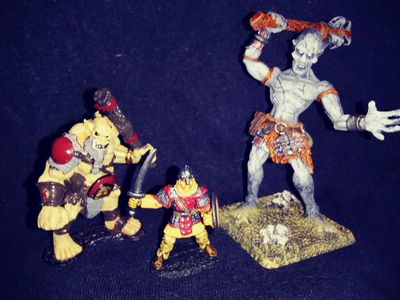The Adventurer's Guild divides encounters into five basic categories:
Animal
Humanoid
Magical/Legendary
Undead
Extra-Planar
An explanation of the classification and rating system is presented below.
Encounter Listings
Extra-Planar
Extra-Planar
Extra-Planar
Creatures originating outside the Prime Material Plane
Alphabetical Listing: Creature and Category
Ankheg Legendary
Ant, Giant Animal
Basilisk Legendary
Bat, Giant Animal
Bear Animal
Bear, Cave Animal
Beholder Legendary
Boar Animal
Bugbear Humanoid
Centipede, Giant Animal
Cerberus Wolf Legendary
Chimera Legendary
Cockatrice Legendary
Crocodile Animal
Crypt Lord Undead
Cyclops Humanoid
Death Knight Undead
Demon (all) Extra-Planar
Derro Humanoid
Devil (all) Extra-Planar
Displacer Beast Legendry
Djinn Extra-Planar
Dragon Legendary
Dragon Turtle Legendary
Drow Elf Humanoid
Drider Legendary
Efreet Extra-Planar
Elemental (all) Extra-Planar
Ettin Humanoid
Frog, Giant Animal
Gargoyle Legendary
Ghast Undead
Ghost Undead
Ghoul Undead
Giant (all) Humanoid
Gnoll Humanoid
Goblin Humanoid
Golem (all) Legendary
Gremlin Legendary
Griffon Legendary
Harpy Legendary
Haunt Undead
Hydra Legendary
Hyena Animal
Imp Extra-Planar
Ithilid Humanoid
Kobold Humanoid
Lich Undead
Lion Animal
Lizard, Giant Animal
Manticore Legendary
Medusa Legendary
Minotaur Legendary
Mummy Undead
Naga Humanoid
Ogre Humanoid
Orc Humanoid
Oriental Dragon Legendary
Owlbear Legendary
Pegasus Legendary
Plague Rat Legendary
Quasit Extra-Planar
Rat, Giant Animal
Reaver Undead
Revenant Undead
Rhemoraz Legendary
Scorpion, Large Animal
Scorpion, Giant Legendary
Shadow Extra-Planar
Shadow Demon Extra-Planar
Shambler Legendary
Skeleton Undead
Slaadi Extra-planar
Snake, Giant Animal
Spectre Undead
Sphinx Legendary
Spider, Large Animal
Spider, Giant Legendary
Stirge Legendary
Swamp Horror Legendary
Tiger, sabre-tooth Animal
Treant Legendary
Tree Sprite Legendary
Troglodyte Orc Humanoid
Troll (all) Legendary
Unicorn Legendary
Vampire Undead
Water Weird Extra-Planar
Werewolf Legendary
Wight Undead
Wolf Animal
Worg Wolf Legendary
Wraith Undead
Yeti Legendary
Zombie Undead
Encounter Rating System

In attempting to classify encounters and creatures, we are inevitably asked two questions: “How dangerous is it?”, and “How hard is it to kill?” Both of answers are rather conditional. Dangerousness can be tricky to define. A cockatrice bite can barely break the skin, small ones can probably be killed in a single weapon blow, but one touch of a feather can turn even the Grand Master of the Wizard’s Guild into a stone statue of himself. Similarly, for someone wearing the Armor of Righteousness and carrying Excalibur, things are going to be a little easier to kill than for someone using an iron table leg and a wicker shield.
There is no substitute for personal experience, but some collective wisdom may help. Over time, the Guild has developed a system which attempts to roughly equate the dangerousness of a given creature with the Guild's ranking system for professions. It is not an exact science, and must be understood in context. If, for example, we equal a sabre-tooth tiger to a rank 7 warrior, we’re not suggesting we’ve been bringing in tigers and testing them on the Guild combat course. Rather, it expresses our experienced opinion that if you wouldn’t feel confident fighting a rank 7 warrior, you might want to stay away from tigers.
The primary factor in our rating system is how tough the creature is. We then consider small value shifts for exceptional attack abilities or unusual characteristics. Creatures are generally equated to an experienced warrior in appropriate gear, and magical abilities (if present) are discussed separately.
All things must be taken in context. No matter how diligently we validate our research, inevitably some creature comes along that is bigger, stronger, faster, or more dangerous a version than has ever seen before. Nonetheless, experience demonstrates that for most potential encounters, a certain degree of predictability emerges for most creatures.

Encounters are classified on a scale of 0 - 10, then A - D
Creatures at class 0 are particularly weak, and can frequently be killed by a single solid weapon blow. They represent “easy” encounters even for a novice adventurer.
Classes 1 through 4 are roughly equal to fighter-types of the same ranking, so for example a class 3 encounter is approximately equal to a rank 3 warrior, paladin, ranger, etc. This assumes the fighter is appropriately equipped for his/her level. It reflects primarily mundane rather than magical characteristics, hence the cockatrice (again as an example) is a class 2 creature, even though its feathers are potentially deadly to anyone.
For classes 5 through 9, we use a more rapidly-ascending scale. Each of these classes represents a relative increase of two profession rankings rather than one: a class 5 equates to a 5th or 6th rank adventurer, class 6 to 7th and 8th rank, and so on. This means each class increase implies a creature distinctly more powerful than the prior rank.
Class 10 and beyond defines encounters of the highest potential danger, and in all cases are creatures or encounters of truly legendary status (hence, “legendary scale”). Class 10 is used for creatures with overwhelming but typically mundane abilities, a mountain troll being a classic example. Class A represents those creatures whose “overwhelmingness” includes magical power, such as a demon. Grades beyond this are almost purely academic, and merely relate the amount of out-of-proportion stupendous power the creature represents, such as comparing a lich (B) with a demi-lich (C). Since the only thing more powerful would have to be an actual god manifesting on the plane, class D stands for deity, and has no actual meaning as an encounter.
In addition, we occasionally have to attempt to quantify another difficult-to-measure attribute, that being magic resistance. Because by its nature this ability is interactive with originator of the magic, it becomes challenging to estimate the precise base-line values for any given individual creature, or to extrapolate it to the general population. As a result, we use the following terms to represent relative ranges of magic resistance:
Minimal: 10% or less
Low: up to 20%
Moderate: up to 35%
Substantial: up to 50%
Superior: up to 60%
Surpassing: up to 75%
Overwhelming: up to 90%
Godlike: anything higher
This website uses cookies.
GoDaddy uses cookies to analyze website traffic, which helps me (Kim) know how the site being visited. Annoying but necessary. Message will not repeat if cookies are accepted.